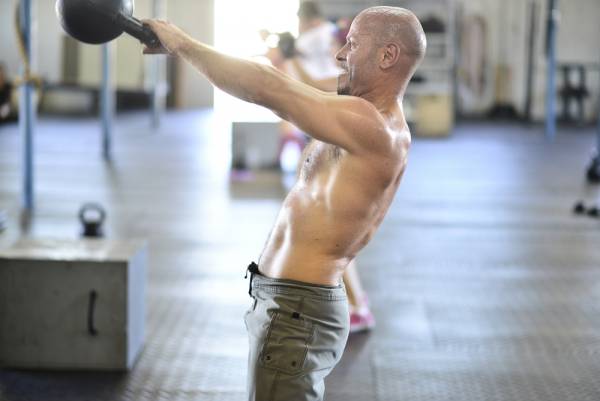So you’re forty. You’ve got kids and a real job. You want to be fit and work hard like you used to, but life is getting in the way. That doesn’t make you weak or undisciplined. Work does come first, and family is a real responsibility.
RELATED: Grow Older and Get Stronger With Our Mature Athlete Workouts
Finding the Time to Train
Things won’t get better in your fifties either. You’ll have even more responsibilities at work and while your kids will be somewhat self-sufficient, you’ll have bigger problems to deal with – teen drunkenness, driving, college, dating. Time may dwindle even more, but staying in shape will be every bit as important. If you’re unwell, how will the bills get paid if you’re off work?
Physical fitness remains important at every age. But finding the time for it does get harder as you get older, as you’re likely to have more time-draining responsibilities. It’s not selfish to take the time to train. In fact, I’d argue it makes you a better partner, employee, and human. But how do you get a good workout in a relatively short time frame?
Disclaimer: if you are training for a singular purpose right now, then ignore this. If you are hell bent on a triathlon, a weightlifting meet, the CrossFit Open, or anything similar, this article is not for you. For everyone else wanting to figure out how to make “just training” work, read on.
RELATED: It’s Not Too Late to Prepare for the CrossFit Games Open
You Are Training for GPP
The first reality check you need is to realize you are training for general physical preparedness (GPP). That means you do not need any specific training plan. Oh, I know, you’ll get a bigger squat if you switch to the double-split Smolov plan, but if you’re not competing in a lifting competition any time soon, then the only thing you’re likely to get from such a plan is a trip to an orthopedic surgeon.
“The first reality check you need is to realize you are training for general physical preparedness (GPP). That means you do not need any specific training plan.”
But if you just accept that what you’re training for is “not to suck at life,” then it allows you far more freedom when you train. That freedom is going to prevent burnout and injuries caused by overuse of one pattern.
I like to split the week into four workouts. The four workouts are all whole body affairs, but with a different emphasis each day.
- Day one is upper body.
- Day two is conditioning.
- Day three is lower body.
- Day four is mobility.
If you want to train more than four times per week, go for it – just cycle back through the four. Take rest days when and how you see fit and carry on with whatever the next workout in the sequence is.
Why do the days get structured like this?
- The upper body recovers much faster than the lower body, and it’s possible to hit the upper body hard while your legs are still not feeling so great.
- The next day is a conditioning day because doing two hard strength days back to back might be difficult with slower recovery ability. Not only that, but as you age heart health is something you need to address and this session will help with that.
- Then we hit lower body hard on the third day.
- The final workout for the week is a mobility session to reset everything and get it all working properly again for the next four day cycle.
RELATED: Mobility Work: You’re Doing It Wrong (and Too Long)

Movement Explanations
Each workout should lead off with a big whole body athletic lift. You then need an upper body push and pull and a lower body squat pattern. Don’t worry about the hinge, as you’ll be taking care of that with kettlebell swings or snatches. Finish with ab work.
- Whole body lift: Power snatch, power clean, snatch or clean pulls, double kettlebell clean and jerks or double snatches.
- Upper body push: Jerks, push presses, presses, bench press, dips.
- Upper body pull: Pull ups, chin ups, rows.
- Squat pattern: Goblet squats, double kettlebell squats, overhead squats, front squats, back squats, Bulgarian squats, King deadlifts.
- Ab work: You need both ab strength work (exercises that you flex for, such as sit ups and leg raises) and anti-flexion work (planks, roll outs and levers). Pick both a flexion and anti-flexion exercise every session.
“Each workout should lead off with a big whole body athletic lift. You then need an upper body push and pull and a lower body squat pattern.”
For conditioning, get outside as much as possible. Get out and move around for a long time – at least an hour. Walking and running are always the best choices if your body can deal with it. Yes, I’m well aware that walking isn’t sexy, but living a long time is and there’s plenty of research that shows those who walk often live the longest. (Read this and this and this.)
Sample 4-Day Plan
Day 1 – Upper Body Focus
Power snatch off blocks – 3 sets of 3 with two warm up sets
Barbell press behind neck – 5 sets of 5
Pull ups – 5 sets of 5
Note: You can even do these as super sets, taking a minute or two between sets to save some time.
AMRAP in 20 minutes:
Goblet squats x 5 reps
Kettlebell swings x 10 reps
This gets our squat pattern work done while giving us some incidental conditioning and hinge work.
Hanging leg raise x 5-10 reps
Ab wheel x 5-10 reps
3 sets of each, alternating from one to the other, as close to no rest as possible.
RELATED: The Training Solution for the 40+ Athlete

Day 2 – Conditioning
Precede run with three rounds of:
20 squats
15 sit-ups
10 push-ups
5 pull-ups
You’ll note this hits all our push, pull, squat, ab needs for the day.
Then, run or walk for an hour.
Day 3 – Lower Body Focus
Clean – 3, 2, 1 by two waves increasing weight each set.
Clean pulls – 3 sets of 3, with two warm up sets.
Back squat – 5 sets of 3 increasing weight each set, with the final set a working 3RM.
Hanging leg raise – 3 sets of 10.
Push up/plank holds – perform push ups for 30 seconds immediately followed by a 30 second plank hold.
Complete four rounds non-stop.
RELATED: Bulls and Toby Keith: Fitness Lessons for the 40+ Athlete
Day 4 – Mobility Focus
Get up/windmill/overhead squat – 1 rep each side for five total reps per side.
Active hangs – 3 sets of 10 reps.
Rest in the squat position using Ido Portal’s Squat Routine 2.0.
AMRAP in 20 minutes:
Hindu push ups x 10 reps
Kettlebell swings x 10 reps
Take Home
You’ll note every single day has work that covers whole body athletic moves, pushing and pulling, squat patterns, and conditioning to varying degrees. It uses a lot of different ways to do this because the body is designed to move in different ways.
“What matters for most people in the forty-plus bracket is effort and consistency.”
There is no need to specialize in a single movement or lift unless you have competitive aims and that lift is necessary. For everyone else, what is important is moving in a variety of ways as often as possible.
For the four days following the example week above, you could keep things close to the same but add a rep here or there. Or, you could choose four completely new days of training. It doesn’t matter.
What matters for most people in the forty-plus bracket is effort and consistency. Turn up, work hard but smart, and then go take care of business and your family.
Photos 1 & 2 courtesy of Shutterstock.
Photo 3 courtesy of CrossFit Empirical.






